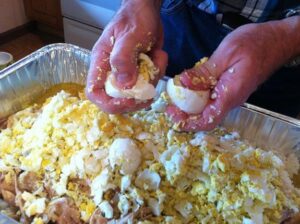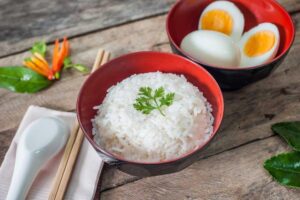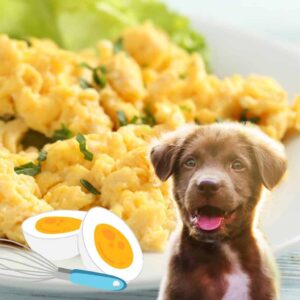Dogs love to eat, but most of the time, they don’t want to eat what’s on their plate. That’s why we came up with this recipe for homemade rice and eggs for dogs: a food that dogs love. Relax and read through as we dive into the details.
Rice and eggs can be nutritious to a dog’s diet if prepared and served safely and appropriately. Rice is a good source of carbohydrates, which can provide energy for your dog.
Also, it is low in fat and has a moderate amount of protein. Eggs are an excellent source of high-quality protein and essential vitamins and minerals, such as vitamin A, riboflavin, and selenium.
However, it is essential to note that rice and eggs should only be given to dogs as an occasional treat or supplement to their regular diet rather than as a primary source of nutrition. Dogs require a well-balanced diet with various nutrients, including proteins, fats, and carbohydrates.
Homemade Rice and Eggs for Dogs

It is safe to feed your dog a homemade meal of rice and eggs as long as it is cooked and served correctly. Rice and eggs can be nutritious and easily digestible meals for dogs, providing a good source of energy, protein, and other essential nutrients.
However, it is essential to remember that dogs have different nutritional needs than humans, and it is important to consult with a veterinarian or a pet nutritionist to determine the appropriate amount and type of food to feed your dog.
To make a homemade rice and eggs meal for your dog, you will need the following ingredients:
· Cooked white or brown rice (avoid seasoning or adding any extra ingredients)
· Hard-boiled or scrambled eggs (without any seasonings or additives)
To prepare the meal:
1. Cook the rice according to package instructions without adding any seasonings or additives.
2. Hard-boil or scramble the eggs, removing any shells or membranes.
3. Combine the cooked rice and eggs in a bowl, and mix well.
Lastly, allow the mixture to cool to a safe serving temperature before giving it to your dog. It is important to remember that rice and eggs should only be a small part of your dog’s diet and should not be fed as a sole source of nutrition.
It is vital to provide a balanced diet that meets your dog’s nutritional needs, including appropriate amounts of protein, fat, and carbohydrates, as well as essential vitamins and minerals.
Can I give my dog rice and eggs for upset stomach?
It is generally safe to give your dog a small amount of cooked rice and boiled eggs as a temporary measure to help settle their stomach. However, it’s important to note that this should not be fed as a regular meal and should only be given in moderation as a temporary solution.
Rice can help to bulk up the stools and can be easily digested, making it a good option for dogs with an upset stomachs. Boiled eggs are also a good source of protein and can be easily digested when cooked.
It’s always a good idea to consult your veterinarian before giving your dog any new food, especially if they are experiencing digestive issues. Your veterinarian can recommend the best course of action and will be able to provide specific recommendations based on your dog’s individual needs.
Is it OK to give dogs rice everyday?
Rice is safe to feed your dog a small amount of rice as an occasional treat. Rice can be a good source of energy and nutrients for dogs and may be especially helpful for pregnant, nursing, or recovering from illness.
However, it is essential to remember that rice should not be the main component of a dog’s diet. Dogs require a balanced diet that includes a variety of protein sources and a range of vitamins and minerals.
Feeding your dog a diet consisting mainly of rice can lead to deficiencies in certain nutrients and may cause digestive problems. Should not feed rice to dogs as the primary source of nutrition and should not be provided to puppies or nursing mothers.
If you want to include rice in your dog’s diet, it is best to do so in moderation and as a supplement to a balanced diet that provides high-quality, nutrient-rich dog food.

Can I mix an egg with my dogs food everyday?
You can mix an egg with your dog’s food every day. Eggs are a nutritious food that can be a good source of protein for your dog. However, it is crucial to be aware of a few things when feeding your dog eggs:
1. Should not feed raw eggs to dogs. Raw eggs may contain bacteria that can cause food poisoning in humans and dogs. Cooked eggs are safer to feed your dog.
2. Some dogs may be allergic to eggs. If you are unsure whether your dog is allergic to eggs, it is best to consult your veterinarian.
3. If you are feeding your dog eggs as a protein source, it is crucial to ensure that the eggs are cooked and not the central part of their diet. Dogs need a balanced diet that includes a variety of nutrients, and eggs should only be fed as a supplement to their regular diet.
Finally, it is generally safe to mix an egg with your dog’s food daily as long as it is cooked and fed in moderation as part of a balanced diet.
Is homemade dog food safe?
Homemade dog food can be safe for dogs if it is balanced and meets their nutritional needs. It is essential to consult with a veterinarian or a pet nutritionist to ensure that the homemade diet is complete and balanced. This is especially important for puppies, senior dogs, and dogs with certain medical conditions.
Following food safety guidelines when preparing homemade dog food is vital to preventing food poisoning. This includes washing hands and surfaces thoroughly, properly storing ingredients, and cooking meat to a safe temperature.
It is important to note that homemade dog food may only be suitable for some dogs and may be more time-consuming and costly to prepare than commercial dog food. It is always a good idea to consult a veterinarian or a pet nutritionist before making any changes to your dog’s diet.
What is the best homemade food to feed a dog?
The best homemade food balanced diet for a dog should include a variety of protein sources, such as meat, poultry, fish, and eggs. It should also have a source of carbohydrates, such as rice, pasta, or potatoes, and a source of fat, such as olive oil or coconut oil. Vegetables and fruits can be included as additional sources of nutrients and fiber.
It’s essential to avoid adding salt, sugar, and other seasonings to your dog’s food and avoid toxic or harmful ingredients such as onions, garlic, and chocolate.
When preparing homemade dog food, it’s essential to carefully measure and balance the ingredients to ensure that your dog gets all the nutrients they need. It’s also a good idea to include a supplement, such as a multivitamin, to help ensure that your dog gets all the necessary nutrients.

Is it better for dogs to eat homemade food?
There are pros and cons to feeding dogs homemade food. One advantage of homemade food is that you can control the ingredients and tailor the diet to meet your dog’s specific needs or preferences.
For example, if your dog has food allergies or sensitivities, you can choose ingredients that do not trigger a reaction. Homemade food can also be a good option for dogs with certain medical conditions that require a special diet.
On the other hand, preparing homemade dog food can be time-consuming and require more effort and resources than feeding a commercially prepared diet. It is vital to ensure that the diet is nutritionally balanced and meets all of your dog’s nutritional needs.
This may require the assistance of a veterinarian or a veterinary nutritionist to formulate the diet and ensure that it is safe and appropriate for your dog.
In general, discussing your dog’s diet with a veterinarian or a veterinary nutritionist is a good idea to determine the best feeding options for your dog. They can help you weigh the pros and cons of homemade food and decide whether it is a suitable option for your dog.
What vegetables should I put in my dog’s homemade dog food?
It can include a variety of vegetables in homemade dog food, but it is essential to be mindful of which vegetables are safe for dogs and which should be avoided.
Some safe vegetables for dogs include:
Carrots: These are a great source of beta-carotene and fiber for dogs. They can be grated or finely chopped and added to the food.
Green beans: Green beans are a good source of fiber, vitamin C, and vitamin K for dogs. Depending on your dog’s size and preference, they can be cooked and mashed or served whole.
Sweet potatoes: Sweet potatoes are a good source of beta-carotene, vitamin C, and potassium for dogs. They can be baked, boiled, and mashed before being added to the food.
Pumpkin: This is a good source of fiber and beta-carotene for dogs. It can be pureed and added to food.
Broccoli: This is a good source of fiber, vitamin C, and vitamin K for dogs. It should be cooked and mashed before being added to the food, as dogs may have trouble digesting it raw.
It is essential only to feed your dog small amounts of vegetables, as they should not make up most of their diet. The primary source of nutrition in your dog’s diet should be high-quality commercial dog food or a homemade diet that includes a variety of proteins.
If you are considering adding vegetables to your dog’s diet, it is always a good idea to consult a veterinarian or a pet nutritionist for guidance.

What are the essential ingredients for homemade dog food?
Homemade dog food typically consists of a combination of protein, carbohydrates, and vegetables. You must ensure that the diet is balanced and meets the individual dog’s nutritional needs.
Here are some general guidelines for making homemade dog food:
Protein: This can be provided through a variety of sources, such as meat (such as beef, chicken, or lamb), fish, eggs, or tofu. Choosing a protein source appropriate for your dog’s size, age, and health status is essential.
Carbohydrates: These can be provided through whole grains, such as brown rice, oats, quinoa, or vegetables, such as sweet potatoes or peas.
Vegetables: Vegetables can provide essential nutrients and fiber to the diet. Some good options include dark leafy greens, such as spinach or kale, and cruciferous vegetables, such as broccoli or Brussels sprouts.
Other essential nutrients: It is crucial to ensure that the homemade diet includes appropriate amounts of essential fatty acids, such as omega-3 and omega-6, as well as vitamins and minerals. Some owners choose to add supplements to their diet to ensure that their dog gets all the necessary nutrients.
How much rice to feed dog with diarrhea?
You can feed a dog with diarrhea a bland, easily digestible diet to give its digestive system a chance to rest and recover. Rice is a common ingredient in these diets because it is a simple carbohydrate that is easy for dogs to digest. The amount of rice to feed a dog with diarrhea will depend on the size and breed of the dog with the severity of the diarrhea.
As a general rule, you should feed your dog with diarrhea small, frequent meals of a mixture of cooked white rice and a protein source, such as boiled chicken or ground beef. The ratio of rice to protein should be about 2:1, with more rice than protein. For example, you might feed a small dog with diarrhea 1/2 cup of cooked white rice mixed with 1/4 cup of boiled chicken at each meal.
It is essential to consult with your vet or dietician before making any changes to your dog’s diet, especially if the diarrhea is severe or persistent.
How to make scrambled eggs for dogs

To make scrambled eggs for dogs, you will need the following:
1. 1 egg
2. 1 teaspoon of butter or cooking oil
3. A small frying pan
Instructions:
1. Crack the egg into a small bowl and beat it lightly with a fork.
2. Heat the butter or cooking oil in the frying pan over medium heat.
3. Pour the beaten egg into the frying pan and scramble it gently with a spatula or fork until it is fully cooked.
4. Let the scrambled eggs cool to room temperature before serving them to your dog. You can help the scrambled eggs as a treat or mix them into your dog’s regular food.
Remember that eggs can be a healthy treat for dogs, but they should not make up a large portion of your dog’s diet. Consult with a veterinarian or a pet nutritionist if you have concerns about your dog’s diet.
How to make rice for dogs with diarrhea
If you want to feed dogs with diarrhea a bland diet to help settle their stomach and firm up their stools. One option for a bland diet is rice and boiled chicken or white fish. Here’s a recipe you can try:
1. Rinse 1/2 cup of white rice in a fine mesh strainer under cold running water.
2. Bring 1 1/2 cups of water to a boil in a medium saucepan.
3. Add the rinsed rice to the boiling water, reduce the heat to low, and simmer, covered, for 18-20 minutes, or until the water has been absorbed and the rice is tender.
4. While the rice is cooking, boil 4 ounces of boneless, skinless chicken breast or white fish in a separate pot of water until cooked through.
5. Once the chicken or fish is cooked, remove it from the pot and let it cool. Then shred or chop it into small pieces.
6. When the rice is done cooking, let it cool slightly, then mix in the shredded chicken or fish.
7. Serve the rice and chicken or fish mixture to your dog, making sure it is at a safe temperature before giving it to them.
It is important to note that this is only a temporary solution, and you should consult your veterinarian if your dog’s diarrhea persists. Your vet will be able to recommend a more appropriate diet plan and may suggest additional treatment options.
What three ingredients should not be in dog food?
Several ingredients should not be included in dog food, either because they are harmful to dogs or provide little or no nutritional value. These ingredients include:
1. Onions and garlic
These vegetables can cause anemia in dogs if consumed in large quantities.
2. Avocado
The leaves, fruit, seeds, and bark of avocados contain persin, which can cause vomiting and diarrhea in dogs.
3. Chocolate
Chocolate contains theobromine, which can be toxic to dogs. It can cause symptoms such as vomiting, diarrhea, rapid breathing, increased heart rate, and tremors.
Others
Artificial colors and flavors: These ingredients are often added to pet food to make it more appealing to humans, but they offer no nutritional value and may be harmful to dogs. Some artificial colors have been linked to cancer, and artificial flavors may contain chemicals that are toxic to dogs.
You must carefully read the ingredient list on commercial dog foods and avoid products containing these ingredients. It is also essential to keep these ingredients out of dogs’ reach and avoid feeding them to your dog. Avoid these ingredients when making homemade dog food, and use only safe, nutritionally appropriate ingredients.
If unsure which ingredients are safe or suitable for your dog, it is a good idea to consult a veterinarian or a veterinary nutritionist.

What do vets say about homemade dog food?
Homemade dog food can be healthy and nutritious if properly balanced and meets all of the dog’s nutritional needs.
Vets may recommend homemade dog food as an alternative to commercial pet food for dogs with certain medical conditions, such as food allergies or sensitivities, or for dogs that are overweight or have other specific dietary requirements.
However, it is essential to consult with a veterinary nutritionist before starting a homemade dog food diet. It is also vital to be careful when preparing homemade dog food, as some human foods can be toxic to dogs.
Is homemade dog food with pumpkin safe?
Pumpkin can be a safe and nutritious addition to your dog’s homemade diet. Pumpkin is a good source of fiber, which can help regulate bowel movements and support digestive health. It is also low in calories and contains vitamins and minerals that can benefit your dog’s overall health.
When adding pumpkin to your dog’s homemade diet, it is essential to use pure pumpkin puree, not pumpkin pie filling, which may contain added sugar and spices that are not safe for dogs.
Pumpkin can be mixed into your dog’s regular food or used as a topping or treat. It is best to start with small amounts and gradually increase them based on your dog’s tolerance and any potential digestive issues.
Can you put canned pumpkin in homemade dog food?
Canned pumpkin can be a nutritious and beneficial ingredient in homemade dog food in small amounts. Pumpkin is a good source of fiber, which can help to firm up loose stools and promote healthy digestion. It is also low in fat and calories, making it a suitable option for dogs that need to maintain a healthy weight.
When using canned pumpkin in homemade dog food, it is essential to choose pure pumpkin puree rather than pumpkin pie filling, which may contain added sugars and spices that are unsafe for dogs. Canned pumpkin can be mixed into the food or added as a topping.
Using only a small amount is essential, as too much pumpkin can cause diarrhea. As a general rule, a good starting point is to use about one tablespoon of pumpkin puree per 20-30 pounds of body weight per day.
If your dog has any medical conditions or allergies, it is essential to consult a veterinarian. They can help you determine if canned pumpkin is a safe and appropriate ingredient for your dog’s homemade food.
Conclusion
We hope you found this article helpful. We know that homemade rice and eggs for dog preparation can be time-consuming, but they’re easy to make, and your dog will love them.
Have fun trying out different flavors and types of rice. For example, we like brown rice or wild rice because they have more fiber and nutrients than white rice. You can also mix up the types of grains. For example, if your dog has no allergies, add an egg yolk or goat cheese.


